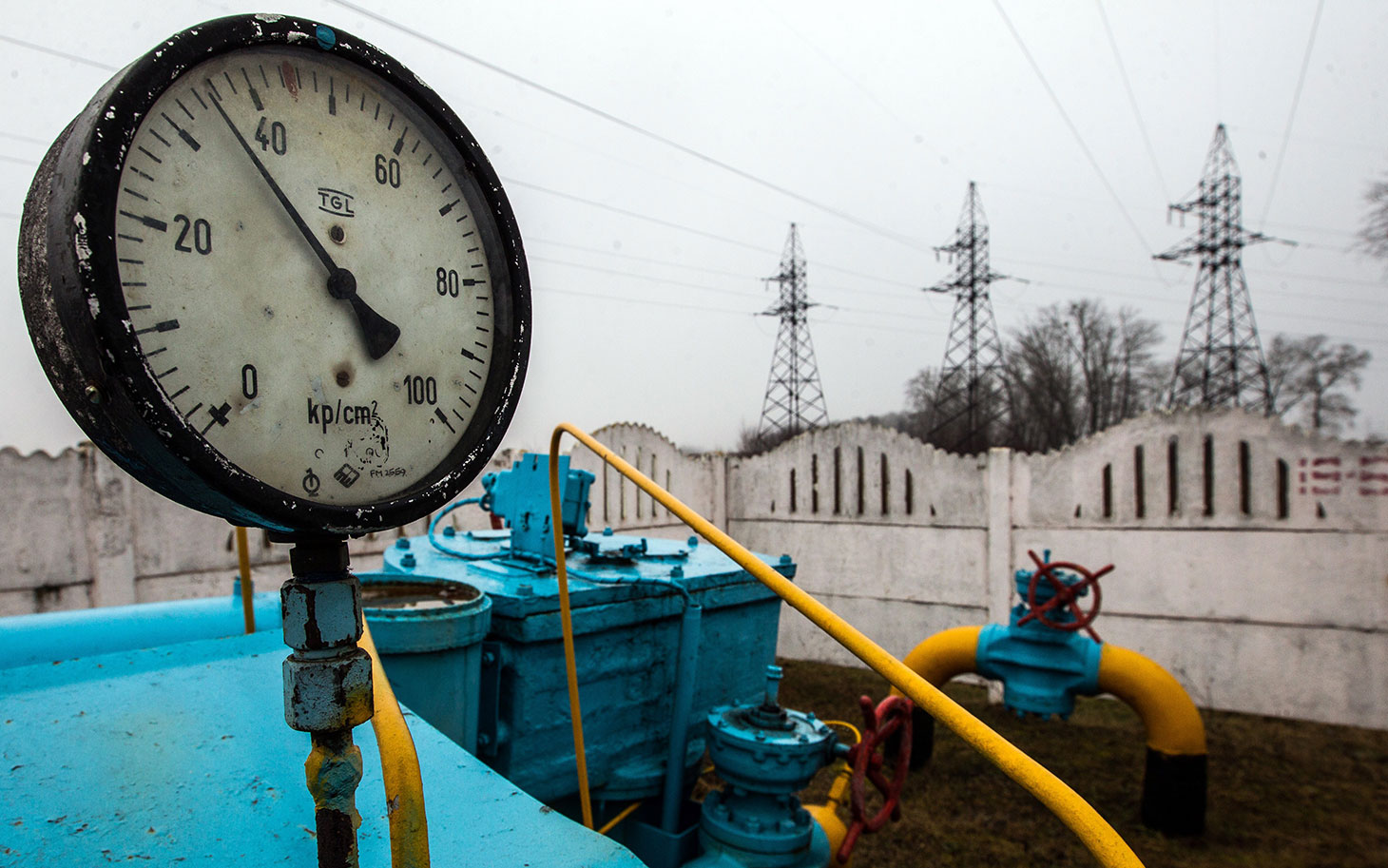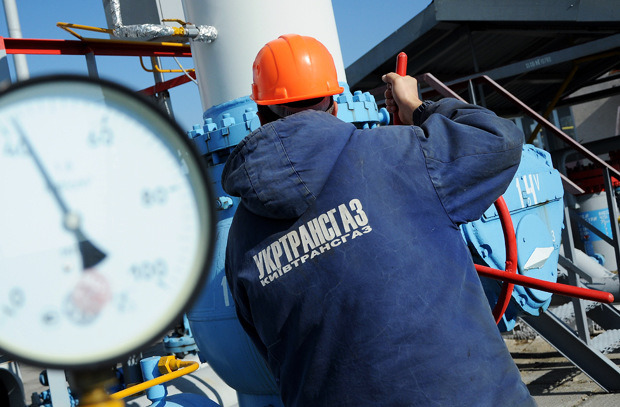Political prejudices interfere with European Countries ability to abandon the crisis of Ukrainian gas transport

Valves of gas pipe-line are seen in the gas station not far from Kiev on March 4, 2014. AFP PHOTO/ ANDREY SINITSIN (Photo credit should read ANDREY SINITSIN/AFP/Getty Images)
Originally appeared at Rusplt, translated by Don Courter exlusively for SouthFront
Russia has been the main supplier of gas in Europe for many years and the supply has always arrived in the right quantities at the right time. But in recent years, serious risks for consumers have materialized in Ukraine, such as a major deficiency in funds used to purchase gas and quality technical services used in the gas-transport system, which has become the subject of blackmail on the part of our neighbor in disputes about the price of Russian gas. It looks like it is time to admit the obvious: Ukrainian gas-transport systems can no longer guarantee a reliable supply of natural gas to the EU nor the safety of the life of every Ukrainian.
The degree of wear and tear on the verge of fantasy
Following a meeting with the Deputy Prime Minister of Slovakia on investments, Economic Development Minister Alexei Ulyukayev not only affirmed that all existing transit agreements would be carried out, but also warned European partners of the technical risks associated with the maintenance of the Ukrainian gas transportation system. According to Ulyukayev, severe underinvestment in the Ukrainian gas transportation system increases the risk of supply disruption and even man-made catastrophes of various scales.
Ulyukayev’s statements regarding the severe underinvestment in the Ukrainian gas transportation system are rooted in hard facts. Today this system is categorized by an extreme depreciation in the quality of equipment and facilities. A major issue has been the low reliability and efficiency of obsolete fuel compressor stations. The neglect of these problems has necessitated increased spending on general repairs and better maintenance of current networks. However, in light of the current political and economic crisis, insufficient fund allocation periodically yields serious consequences. In the beginning of January 2016, a gas pipeline accident occurred in the Transcarpathian region, in the middle of the month – in the Lviv region, and in February – in the Chernigov region.
The main highways of the Ukrainian gas transport system are the pipelines “Union”, “Urengoi – Pomary – Uzhgorod”, “Progress”; they are falling into disrepair and Ukrainians have, at best, patched up some areas. The first pipeline is just under 40 years old, the second – 33, and the third – 30. By 2020, when the present transit contract is completed, all three pipelines will have exhausted their resources (33 years of service). “Without investments, transit will be under constant threat of technological accidents that, without construction of new infrastructure, will endanger the security of the entire country’s gas supply in South Eastern Europe”, stated Deputy Director General of the National Energy Security Fund, Alexei Grivach.

Photo: Danil Shamkin / Zuma / TASS
Still in 2010 the Fuel and Energy Ministry of Ukraine predicted that there must be a 6.5 billion dollar increase in funds for updating the gas transport system – the “Union” pipeline alone (built in the late 1970s and since then not updated) required 2.5 billion. The more recently built (1983) pipeline “Urengoi – Pomary – Uzhgorod” then demanded 1.5 billion dollars for a full scale restoration. The money could not be found (Ukraine fell into desperate strife with Russia over half of its debt) – then, nor could it be found today. According to Associate Professor at the International Business Graduate School of Corporate Management “RANHiGS” Ivan Kapitonov, today’s cost of reconstruction, considering the pipelines’ critical degeneration, would amount to about 9 billion dollars in total.
Sell at any cost
During the regime of former Ukrainian Prime Minister Arseniy Yatsenyuk and in a weak attempt to rectify the situation, Yatsenyuk attempted to sell stakes in the gas transportation system to foreign investors. The proposal was transformed into a thorough sale of the gas transportation system; apparently the sale attracted some new friends of the Ukrainians. But, in the end, no buyers pulled through.
In its own time, when degeneration had not reached critical levels – Russia showed interest in the Ukrainian gas transportation system. In April 2010 during Russian-Ukrainian negotiations, the then-Premier-Minister Vladimir Putin offered to combine merge “Gasprom” and “Naftogas of Ukraine”. Russia was to take up the financial burden of rehabilitating the pipelines and bringing the gas transportation system up to modern standards. Russia also received the opportunity to expand its influence in Europe due to its complete control of the region’s largest pipeline. In turn, the European Union would have enjoyed a more reliable, modern, and energy efficient supply system that would have satisfied domestic demand for years to come.
But this agreement did not pan out. As a result of political and economic differences, the companies’ interests diverged and the pipes were left by themselves for an inexorable amount of time.
Unfortunately, the ever increasing risks of technological catastrophe could not push the European partners to conduct more objective policies in the relationship of “Northern flow – 2”, which permits the circumvention of Ukraine in supplying a new, modern gas transportation system.
This project for a second pipeline system in Germany supported was supported by most developed countries in Western Europe, including France and Italy, but rejected by Eastern European countries, especially Poland, the Czech Republic, and Slovakia, which, if implemented, would have lost income from transit of Russian gas. Ukraine would also have lost transit income (“Haftogas” received 2 billion dollars from these fees in 2015).
Therefore a group of 10 EU countries blocked the execution of the project. Despite the objective threat of disaster, politics trumps common sense and economics. For ordinary Ukrainians who are suffering, if leakage occurs and the pipelines explode, everyone will seem to give a damn.
***
Without alternatives to the current transport system, Ukraine risks catastrophe on all fronts and Russia risks very little. At the same time this problem expresses concern about the situation in our own country. If “Gasprom” suddenly decides to backtrack five years and double the daily transit volume through Ukraine, then they will share in the pressure increase and threat of accidents. Now, reducing the transit volume through Ukraine, “Gasprom” is not only saving on transit costs, but also extending the Ukrainian gas transport system’s life expectancy.
But its days are numbered anyway. To continue to pump flammable fuel through their decrepit pipelines is pure madness.






It’s not the purpose of the west to have a reliable gas pipeline through Ukraine !
The Germans are closing their nuclear power stations! Which means a lot more gas has to be delivered to Germany !
Option one is northstream 2
Option two is pipeline from Qatar to Europe ( but Russia is still keeping the door closed )
In both cases Ukraine Poland ect will lose their transit fee’s which means no necessary investments required for those museum pieces !
Ukrainian politicians are really a bunch of no no’ers , but yeah when you see the fights in the Rada what could you expect from that mentally disabled scum !
Originally the US goal was to insert the US between Russia and Europe, so the US could control energy supplies to Europe, make sure all transactions happen in US dollars.
By limiting gas flows through Ukraine, the US could force Europe to buy gas from US sources, such as the Qatar pipeline and even LNG.
With Russia holding the coastal strip in Syria, the US cannot get its pipeline to Europe built.
At the moment there is a stalemate, Russia cannot build its pipelines to Europe due to US actions, and Russia has responded by blocking US pipelines to Europe.
Just one point about the Qatar pipeline, the gas is actually Iranian gas, but courtesy of US horizontal drilling technology, Qatar is tapping into Iranian fields. The US did the same thing in Kuwait, it drilled into Iraqi oilfields.
The bottom line is The US petro dollar is loosing , Russia is now delivering ( after completion of the pipelines which gives Russian oil a competitive edge ) more oil than SA to China , this oil is paid in Yuan or Rouble , to keep the dollar afloat the US has to find new markets ! Europe is this market , if the Qatar pipeline issue is not resolved than option 2 :
will be to quibble even more with Russia , bigger sanctions ( stop of Russian gas import )
While scalegas from the US and Qatar gas will be provided by ship ! The new gas terminals in Rotterdam whales & klapeida are there , we have only to wait for the sanctions!
Anaconda drill and the ambassy issue between Ukraine and Russia , Might be a catalisator!
Furthermore SA wants to keep it’s market share which means competitors have to be disabled
Nigeria is a designated victim , amnesty international is already complaining about the civil unrest
Oil compagny’s are closing , people are laid off , civil war might be inminant, ==> price of oil will increase , SA world oil share will be kept !
A great read. Would have shared it if it weren’t for the too many typos…